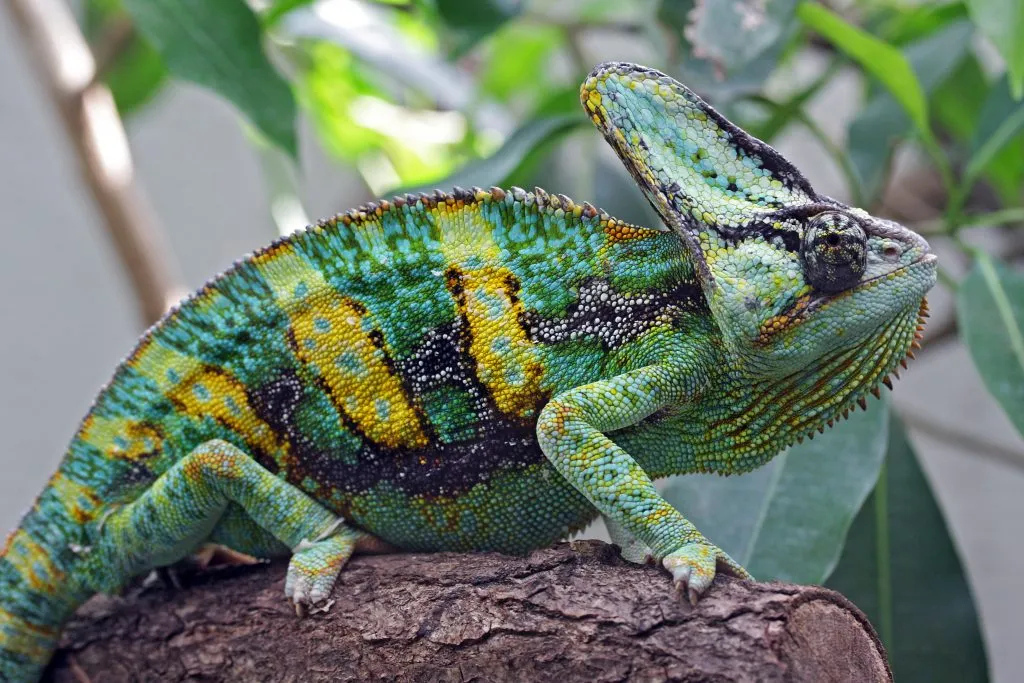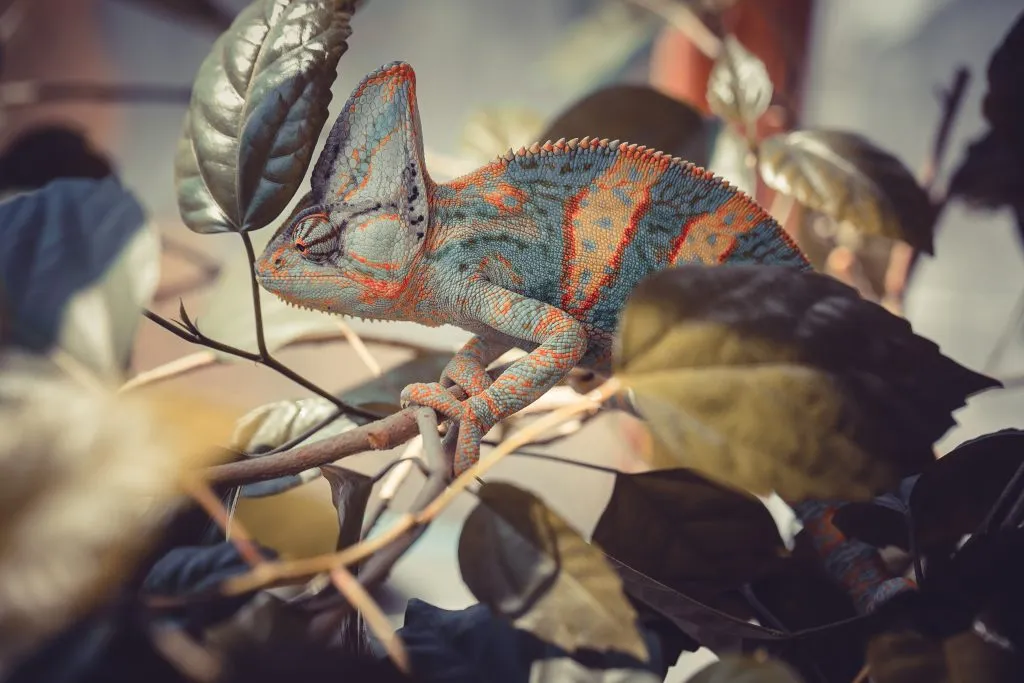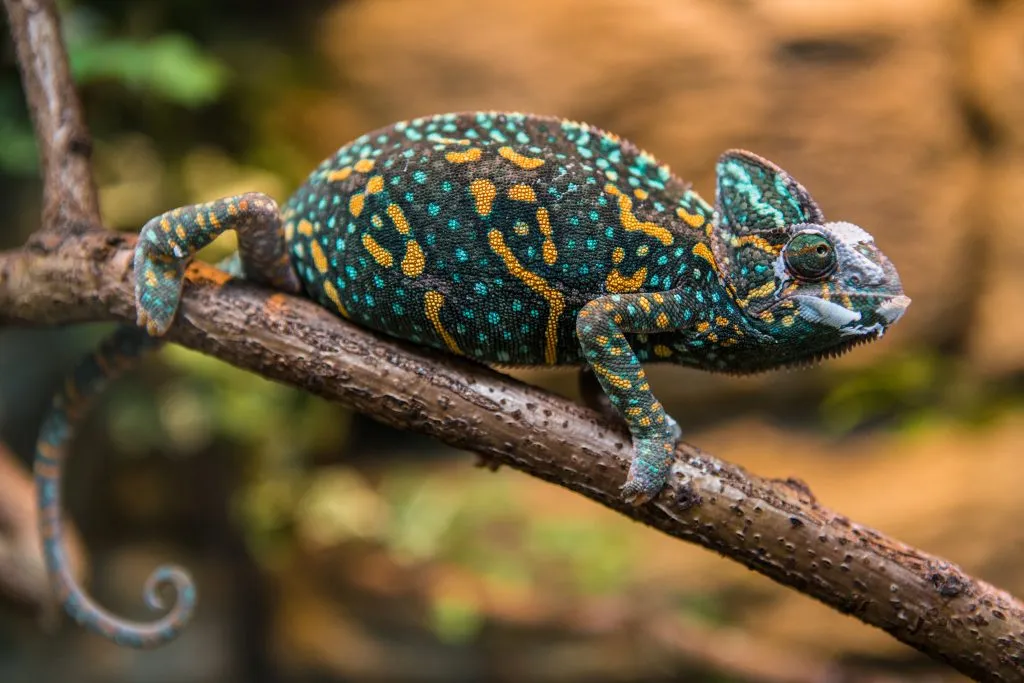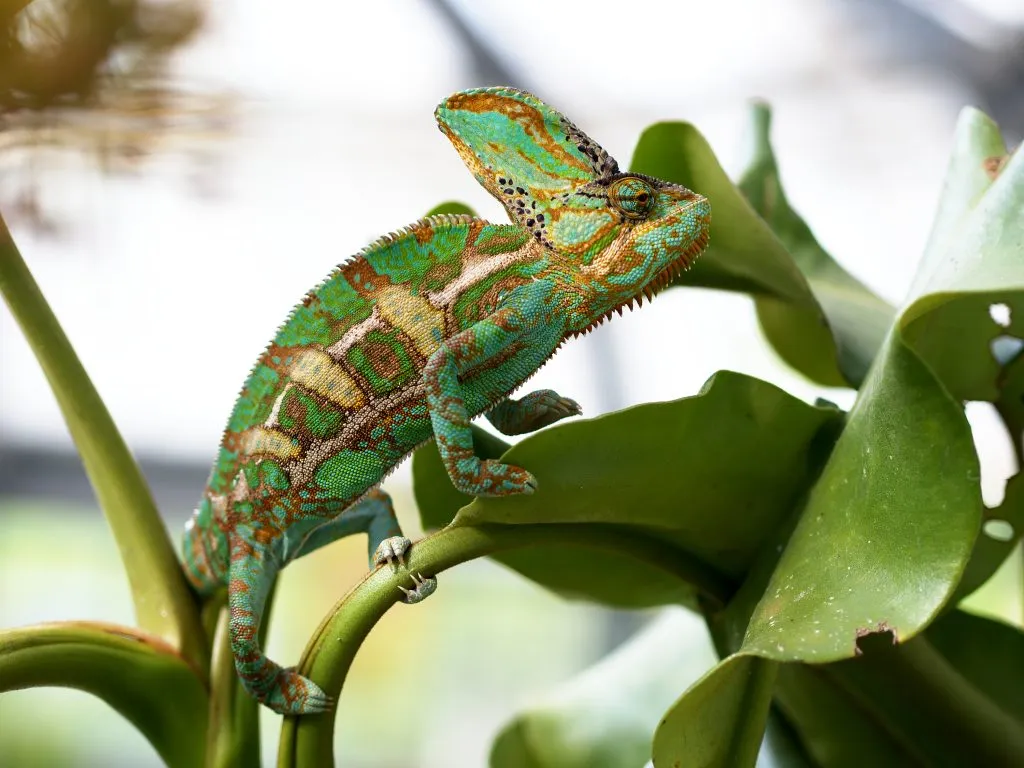
Veiled chameleons are one of the most fascinating and beautiful creatures out there, their striking appearance, ability to change colors, and relative ease of care make them highly popular among pet owners.
However, when getting a veiled chameleon, there are some things you will need to consider in order to keep your pet as healthy as possible. Here is a care sheet that we put together to guide you through what these reptiles need while kept in captivity:
Table of Contents
Veiled Chameleon Facts
| Common name | Veiled chameleon, Yemen chameleon, Cone-headed chameleon |
| Scientific name | Chamaeleo calyptratus |
| Natural habitat | Yemen and Saudi Arabia |
| Adult size | Between 10” and 24” (25cm and 60cm) |
| Enclosure size | At least 24” wide x 24” deep x 36” high (60 cm wide x 60 cm deep x 90 cm high) |
| Diet | Crickets, fruit flies, house flies, mealworms, wax worms. Salads and fruits. |
| Lifespan | 4-6 years for males and 2-3 years for females in captivity. |
| Experience level | Intermediate. |
Where Do Veiled Chameleons Live?
Veiled chameleons are native to plateaus of mountainous regions, forests, and valleys of the Southwestern Arabian peninsula, specifically Yemen and Saudi Arabia.
These reptiles thrive in semi-arid to tropical climates, which makes them quite hardy and able to tolerate a broad range of conditions in captivity.
Veiled Chameleons Appearance, Colors And Morphs

Veiled chameleons are characterized by having a laterally compressed body, a head casque, independently movable eyes, a long projectile tongue, a prehensile tail, and talon-like feet.
Males have a larger and taller casque than females, and also have a visible spur on the back of their hind feet that is not present in female veiled chameleons.
Thanks to special pigmented cells in their skin, veiled chameleons can change color within seconds.
However, contrary to popular belief, they don’t do it to blend into their surroundings, but rather to communicate with other chameleons or to express dominance in the case of males.
Females are generally light green with white accents, while males are usually light green with accents of different shades of green, blue, yellow, and brown.
When a male is defending his territory against another male, he will change his colors to bright red, orange, and white.
When pregnant, females can turn dark blackish-green with turquoise and orange streaks.
How Big Do Veiled Chameleons Get?
Adult females can reach a length of 10’’ to 14’’ (25 to 35 cm), while males can grow to a length of 16’’ to 24’’ (40 to 60 cm). The tail makes up for roughly half the total length of the chameleon.
When it comes to weight, females can average between 90 to 120 gr and males can range from 100 to 200 gr.
Veiled Chameleons Lifespan
The lifespan of captive veiled chameleons is approximately 4 to 6 years for males and 2 to 3 years for females.
However, there have been reports of veiled chameleons living for over 10 years.
How To Care For Veiled Chameleons?

Your veiled chameleon’s enclosure should be as natural as possible, while also allowing your pet to roam freely and safely. Let’s review the appropriate setups for the
Veiled Chameleons Tank Setup
Screen enclosures made from mesh are ideal since they allow good ventilation. The minimum size should be 24” wide x 24” deep x 36” high (60 cm wide, 60 cm deep, and 90 cm high). However, the bigger the
Tip: We roughly explain how to set up a
tank for veiled chameleons in this care guide. However, if you need a step-by-step guide on how to set up a veiled chameleon tank, read our article here!
Glass tanks are not recommended since they do not allow good airflow and may cause veiled chameleons to get stressed if they see their own reflection.
Lighting And Temperature
Your veiled chameleon needs a thermal gradient in the enclosure. Make sure to provide a basking area with a heat source (such as reflector spotlights, ceramic bulbs, or standard incandescent light bulbs).
Daytime ambient temperatures should range from 80 to 88°F (26 to 31°C), and from 95 to 110°F (35 to 44°C) in the basking area.
At night, the temperature should drop no more than 10°F (5°C), ranging from 65 to 75°F (18 to 24°C).
It is essential to keep a thermostat, and thermometers placed at each end of the enclosure.
A ceramic heater -covered by a protective mesh- can be used during winter to help maintain the temperature of the enclosure at the desired range.
Regarding lighting, veiled chameleons need 12 hours of light each day.
Do Veiled Chameleons Need UVB?

Ultraviolet (UVB) radiation is necessary to maintain healthy veiled chameleons. UVB should be provided by compact fluorescent bulbs or UVB-emitting fluorescent tubes.
In any case, this light should be placed at around 12 in (30 cm) to the perching branches, and a protective cover should be kept in place to avoid accidental burns on your pet.
You can use a UVB-emitting reptile fluorescent tube like Zoo-Med’s ReptiSun 5.0 (or 10.0 for breeding females).
Keep in mind that occasional exposure to unfiltered sunlight is beneficial for veiled chameleons; however, you must take precautions to avoid overheating.
Substrate
A substrate like fine soil, coconut husk, artificial grass, paper, or large stones, will be adequate to keep stable humidity levels in the enclosure.
When female veiled chameleons are pregnant, they need a diggable substrate like a soil mix to lay their eggs.
Some substrates you can use are:
- Zoo Med Reptile Bark Fir Bedding
- Exo Terra Coco Husk
- Zoo Med Coconut Fiber Substrate
- Zilla Reptile Substrate Liner
Avoid using substrates like gravel or coarse sand, as these can be accidentally eaten by the reptile when trying to catch prey, leading to oral trauma, tongue lacerations, or even obstruction of the intestinal tract.
Humidity

Most of the natural habitat of veiled chameleons is humid; however, these pets cannot tolerate excessive humidity.
A humidity range between 50 to 75% is suitable for veiled chameleons in captivity.
Appropriate humidity levels can be reached by misting the leaves of the plants in the enclosure once to twice per day.
Veiled Chameleons Tank Decor
Your pet’s enclosure should be decorated with lots of live plants such as Ficus, Pothos, and/or Schefflera, and also several horizontal branches or vines placed at different heights and angles and crossing each other for additional perching spots.
If live plants are not an option, plastic substitutes can be used instead.
Branches or vines must allow the veiled chameleon to roam easily around the enclosure and move closer or farther from the basking area. A great option is the Fluker’s Small Animal Bend-A-Branch Pet Habitat Decor.
How To Clean A Veiled Chameleon’s Tank

Daily cleaning of the tank should include:
- Remove fecal and urine wastes
- Remove any uneaten
food - Mist the enclosure
- Check the water bowl for debris
- Remove shedded skin
- Rinse the water dripper
Weekly cleaning of the tank should include:
- Replace the water and clean the water bowl and other aquatic displays
- Turn the substrate or put a clean dry cage carpet on the bottom of the
tank - Scrub all hard surfaces of the
tank , perches, hide boxes, and shelves
You should also perform a thorough clean of furnishings with a safe disinfectant like Flukers Super Scrub Brush with Organic Cleaner or No Scent Reptile – Professional Pet Waste Odor Eliminator and Cleaner, at least once per month.
All furnishings and substrate should be fully replaced at least once per year.
If you don’t want to use commercial chemical products, you can use warm water and soap. Don’t use bleach for routine hygiene and cleaning.
Veiled Chameleon’s Diet
Veiled chameleons are omnivorous, meaning they eat
What To Feed

Veiled chameleons feed primarily on live insects but will also take some plant matter in their diet.
Insects that veiled chameleons eat include crickets, fruit flies, house flies, mealworms, waxworms, silkworms, roaches, and superworms, etc.
The best way to offer these insects is in an opaque raised dish with smooth sides, that way the insects cannot crawl out and the veiled chameleon can easily feed itself.
Other small animals that can be fed occasionally to veiled chameleons include snails, pinkie mice, and small-sized lizards.
For plant matter, you can offer dark mixed greens such as mustard, dandelions, collar, and turnip; as well as hibiscus and dandelion flowers, and a variety of fruits and vegetables like strawberries, raspberries, mango, apple, papaya, squash, and carrots.
How Often To Feed
Young veiled chameleons need to eat every day, 2 to 3 times per day. The best
Adults should eat every other day, and their diet should include insects 2 to 3 times per week, and greens 1 to 2 times per week.
How Long Can They Go Without Food
Veiled chameleons can go 2 to 3 days without
Do Veiled Chameleons Need Water?

Veiled chameleons need water but will refuse to drink from a bowl where the water is still.
In the wild, veiled chameleons drink the dew from leaves; therefore, you have to mimic that environment by misting the enclosure 1 to 2 times per day.
You can also encourage your veiled chameleon to drink by installing a drip system like the NEPTONION Reptile Chameleon Cantina Drinking Fountain Water dripper in the enclosure. The water should fall slowly and form droplets on the leaves where your pet can easily lap it off.
When a drip system is employed, the water should be caught by a dish at the bottom of the cage and you will need to empty it on a regular basis. Constantly running drip systems are not recommended.
Vitamins And Minerals
Vitamin and mineral supplements are necessary for veiled chameleons in captivity.
Feeder insects should be given a nutritious meal 24 to 48 hours before offering them as
Shortly before feeding them to your pet, insects should also be dusted with calcium powder (at each feeding) and a supplement containing vitamins A and D (once or twice per week).
Veiled Chameleon’s Behavior And Temperament

Veiled chameleons are very docile towards humans, but they don’t like being handled, and although they can put on a threat display (open mouth and extension of the throat pouch) they are not usually physically aggressive.
However, amongst themselves, veiled chameleons are not social and are very aggressive.
Groups of females can tolerate and ignore each other as long as their enclosure is big enough so they can get away from each other when needed.
A male can also live among females and they will also ignore each other until a female becomes receptive to breeding.
Males will not tolerate the presence of another male near them. They will get really stressed and aggressive if they see another male in their territory and will attack and bite each other until one of them submit and retreats to another area.
Are Veiled Chameleons Good Pets?
If you are okay with not handling your pet frequently and you also like having them mostly for display purposes, then veiled chameleons make great pets!
Although they rather stay in solitary, you can still hold your veiled chameleon from time to time. To do this, slowly approach your pet and use both hands to pick it up.
Place one of your hands under the front legs of the veiled chameleon and use your other hand to unwind the tail. Then, lift your two hands at the same time while firmly but gently holding your pet until he or she releases its perch.
Once in your hands, allow your veiled chameleon to grip onto your fingers.
Never use force to remove your veiled chameleon from its perch as this can cause serious injuries to the animal.
When putting your pet back into the enclosure, make sure you place them very close to a perch so he or she can hold on to it with their front legs and then follow through with their back legs.
Veiled Chameleon’s Common Health Problems
Veiled chameleons are very hardy animals, but this doesn’t mean they can’t get sick.
Some of the most common health problems in veiled chameleons include:
- Metabolic bone disease
- Dehydration
- Reproductive disease, such as egg binding
- Intestinal parasites
- Toenail loss
- Ocular diseases
- Hypovitaminosis A
- Infections
Where To Buy Veiled Chameleons?

Veiled Chameleon Breeders
Make sure to get your veiled chameleon from a reputable breeder, that way you can avoid some health issues commonly present in wild reptiles, such as intestinal parasites.
Some of the top breeders you might want to consider are:
Veiled Chameleon Price
Veiled chameleon’s prices vary depending on the breeder and can range from $30 to $200, depending on the reptile’s gender, age, color pattern, and other characteristics.
Veiled Chameleon’s Breeding
Males and females signal each other through changes in their color when they are ready to breed. Females show blue markings; while males will get a more intense color and also flatten their body to seem larger, nod their head, and expand their gular pouch.
The male approaches the female and can sometimes be aggressive towards her, if she is receptive then he will follow her and mount her.
Copulation lasts a few minutes and can be repeated several times per day.
When pregnant, the female will reject the male by changing her color to a dark blackish-green with turquoise and orange streaks.
At the last stages of pregnancy, the female will reject
Females can produce around 45 to 90 eggs, multiple times per year.
- Enchi Ball Python: A Unique and Stunning Morph of Python regius - March 27, 2025
- Emerald Tree Monitor: The Enigmatic Green Guardian of the Rainforest - March 26, 2025
- The Egyptian Cobra (Naja haje): A Fascinating Serpent - March 25, 2025
